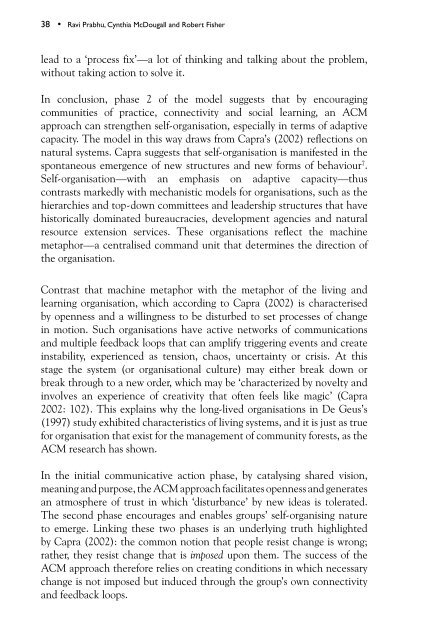Adaptive collaborative management of community forests in Asia ...
Adaptive collaborative management of community forests in Asia ...
Adaptive collaborative management of community forests in Asia ...
You also want an ePaper? Increase the reach of your titles
YUMPU automatically turns print PDFs into web optimized ePapers that Google loves.
38 • Ravi Prabhu, Cynthia McDougall and Robert Fisher<br />
lead to a ‘process fix’—a lot <strong>of</strong> th<strong>in</strong>k<strong>in</strong>g and talk<strong>in</strong>g about the problem,<br />
without tak<strong>in</strong>g action to solve it.<br />
In conclusion, phase 2 <strong>of</strong> the model suggests that by encourag<strong>in</strong>g<br />
communities <strong>of</strong> practice, connectivity and social learn<strong>in</strong>g, an ACM<br />
approach can strengthen self-organisation, especially <strong>in</strong> terms <strong>of</strong> adaptive<br />
capacity. The model <strong>in</strong> this way draws from Capra’s (2002) reflections on<br />
natural systems. Capra suggests that self-organisation is manifested <strong>in</strong> the<br />
spontaneous emergence <strong>of</strong> new structures and new forms <strong>of</strong> behaviour 7 .<br />
Self-organisation—with an emphasis on adaptive capacity—thus<br />
contrasts markedly with mechanistic models for organisations, such as the<br />
hierarchies and top-down committees and leadership structures that have<br />
historically dom<strong>in</strong>ated bureaucracies, development agencies and natural<br />
resource extension services. These organisations reflect the mach<strong>in</strong>e<br />
metaphor—a centralised command unit that determ<strong>in</strong>es the direction <strong>of</strong><br />
the organisation.<br />
Contrast that mach<strong>in</strong>e metaphor with the metaphor <strong>of</strong> the liv<strong>in</strong>g and<br />
learn<strong>in</strong>g organisation, which accord<strong>in</strong>g to Capra (2002) is characterised<br />
by openness and a will<strong>in</strong>gness to be disturbed to set processes <strong>of</strong> change<br />
<strong>in</strong> motion. Such organisations have active networks <strong>of</strong> communications<br />
and multiple feedback loops that can amplify trigger<strong>in</strong>g events and create<br />
<strong>in</strong>stability, experienced as tension, chaos, uncerta<strong>in</strong>ty or crisis. At this<br />
stage the system (or organisational culture) may either break down or<br />
break through to a new order, which may be ‘characterized by novelty and<br />
<strong>in</strong>volves an experience <strong>of</strong> creativity that <strong>of</strong>ten feels like magic’ (Capra<br />
2002: 102). This expla<strong>in</strong>s why the long-lived organisations <strong>in</strong> De Geus’s<br />
(1997) study exhibited characteristics <strong>of</strong> liv<strong>in</strong>g systems, and it is just as true<br />
for organisation that exist for the <strong>management</strong> <strong>of</strong> <strong>community</strong> <strong>forests</strong>, as the<br />
ACM research has shown.<br />
In the <strong>in</strong>itial communicative action phase, by catalys<strong>in</strong>g shared vision,<br />
mean<strong>in</strong>g and purpose, the ACM approach facilitates openness and generates<br />
an atmosphere <strong>of</strong> trust <strong>in</strong> which ‘disturbance’ by new ideas is tolerated.<br />
The second phase encourages and enables groups’ self-organis<strong>in</strong>g nature<br />
to emerge. L<strong>in</strong>k<strong>in</strong>g these two phases is an underly<strong>in</strong>g truth highlighted<br />
by Capra (2002): the common notion that people resist change is wrong;<br />
rather, they resist change that is imposed upon them. The success <strong>of</strong> the<br />
ACM approach therefore relies on creat<strong>in</strong>g conditions <strong>in</strong> which necessary<br />
change is not imposed but <strong>in</strong>duced through the group’s own connectivity<br />
and feedback loops.
















